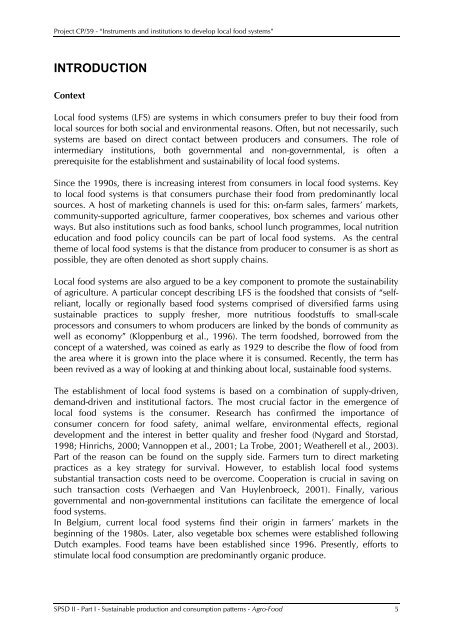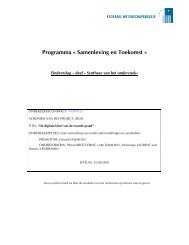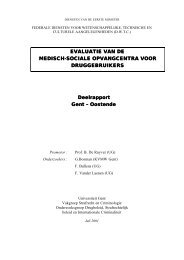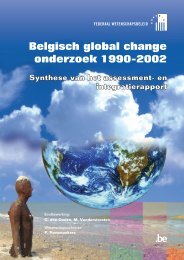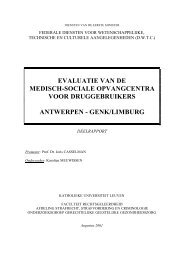chapter 3 inventory of local food systems
chapter 3 inventory of local food systems
chapter 3 inventory of local food systems
You also want an ePaper? Increase the reach of your titles
YUMPU automatically turns print PDFs into web optimized ePapers that Google loves.
Project CP/59 - “Instruments and institutions to develop <strong>local</strong> <strong>food</strong> <strong>systems</strong>”<br />
INTRODUCTION<br />
Context<br />
Local <strong>food</strong> <strong>systems</strong> (LFS) are <strong>systems</strong> in which consumers prefer to buy their <strong>food</strong> from<br />
<strong>local</strong> sources for both social and environmental reasons. Often, but not necessarily, such<br />
<strong>systems</strong> are based on direct contact between producers and consumers. The role <strong>of</strong><br />
intermediary institutions, both governmental and non-governmental, is <strong>of</strong>ten a<br />
prerequisite for the establishment and sustainability <strong>of</strong> <strong>local</strong> <strong>food</strong> <strong>systems</strong>.<br />
Since the 1990s, there is increasing interest from consumers in <strong>local</strong> <strong>food</strong> <strong>systems</strong>. Key<br />
to <strong>local</strong> <strong>food</strong> <strong>systems</strong> is that consumers purchase their <strong>food</strong> from predominantly <strong>local</strong><br />
sources. A host <strong>of</strong> marketing channels is used for this: on-farm sales, farmers’ markets,<br />
community-supported agriculture, farmer cooperatives, box schemes and various other<br />
ways. But also institutions such as <strong>food</strong> banks, school lunch programmes, <strong>local</strong> nutrition<br />
education and <strong>food</strong> policy councils can be part <strong>of</strong> <strong>local</strong> <strong>food</strong> <strong>systems</strong>. As the central<br />
theme <strong>of</strong> <strong>local</strong> <strong>food</strong> <strong>systems</strong> is that the distance from producer to consumer is as short as<br />
possible, they are <strong>of</strong>ten denoted as short supply chains.<br />
Local <strong>food</strong> <strong>systems</strong> are also argued to be a key component to promote the sustainability<br />
<strong>of</strong> agriculture. A particular concept describing LFS is the <strong>food</strong>shed that consists <strong>of</strong> “selfreliant,<br />
<strong>local</strong>ly or regionally based <strong>food</strong> <strong>systems</strong> comprised <strong>of</strong> diversified farms using<br />
sustainable practices to supply fresher, more nutritious <strong>food</strong>stuffs to small-scale<br />
processors and consumers to whom producers are linked by the bonds <strong>of</strong> community as<br />
well as economy” (Kloppenburg et al., 1996). The term <strong>food</strong>shed, borrowed from the<br />
concept <strong>of</strong> a watershed, was coined as early as 1929 to describe the flow <strong>of</strong> <strong>food</strong> from<br />
the area where it is grown into the place where it is consumed. Recently, the term has<br />
been revived as a way <strong>of</strong> looking at and thinking about <strong>local</strong>, sustainable <strong>food</strong> <strong>systems</strong>.<br />
The establishment <strong>of</strong> <strong>local</strong> <strong>food</strong> <strong>systems</strong> is based on a combination <strong>of</strong> supply-driven,<br />
demand-driven and institutional factors. The most crucial factor in the emergence <strong>of</strong><br />
<strong>local</strong> <strong>food</strong> <strong>systems</strong> is the consumer. Research has confirmed the importance <strong>of</strong><br />
consumer concern for <strong>food</strong> safety, animal welfare, environmental effects, regional<br />
development and the interest in better quality and fresher <strong>food</strong> (Nygard and Storstad,<br />
1998; Hinrichs, 2000; Vannoppen et al., 2001; La Trobe, 2001; Weatherell et al., 2003).<br />
Part <strong>of</strong> the reason can be found on the supply side. Farmers turn to direct marketing<br />
practices as a key strategy for survival. However, to establish <strong>local</strong> <strong>food</strong> <strong>systems</strong><br />
substantial transaction costs need to be overcome. Cooperation is crucial in saving on<br />
such transaction costs (Verhaegen and Van Huylenbroeck, 2001). Finally, various<br />
governmental and non-governmental institutions can facilitate the emergence <strong>of</strong> <strong>local</strong><br />
<strong>food</strong> <strong>systems</strong>.<br />
In Belgium, current <strong>local</strong> <strong>food</strong> <strong>systems</strong> find their origin in farmers’ markets in the<br />
beginning <strong>of</strong> the 1980s. Later, also vegetable box schemes were established following<br />
Dutch examples. Food teams have been established since 1996. Presently, efforts to<br />
stimulate <strong>local</strong> <strong>food</strong> consumption are predominantly organic produce.<br />
SPSD II - Part I - Sustainable production and consumption patterns - Agro-Food 5


